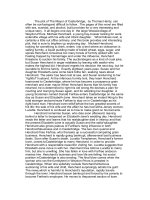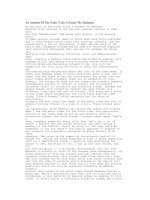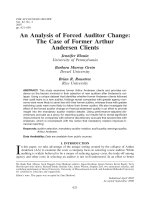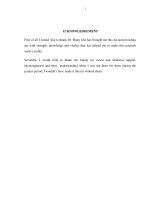An Analysis of the Argumentative Writing Skills of Academically Underprepared College Students pptx
Bạn đang xem bản rút gọn của tài liệu. Xem và tải ngay bản đầy đủ của tài liệu tại đây (6.52 MB, 145 trang )
An Analysis of the Argumentative Writing Skills of Academically
Underprepared College Students
Beth Jillian Chase
Submitted in partial fulfillment of the Requirements for
the degree of Doctor of Philosophy
under the Executive Committee of The Graduate School of Arts and Sciences
COLUMBIA UNIVERSITY
2011
© 2011
Beth Jillian Chase
All Rights Reserved
ABSTRACT
An Analysis of the Argumentative Writing Skills of Academically
Underprepared College Students
Beth Jillian Chase
The present study was conducted to extend what is known about the writing skills of low
achieving postsecondary students. Using an archival data set, a sample of argumentative essays
written by community college developmental (remedial) education students was analyzed.
Scoring procedures for argumentation development were implemented based on a framework
developed by Ferretti, Lewis, and Andrews-Weckerly (2009) and adapted by the current author
to accommodate the tasks of the writing prompt. The goals of the study were: (1) to determine to
what extent the argumentative essays written by community college remedial students are
inclusive of functional argumentative elements, coherent, cohesive, and of high quality; and (2)
to determine to what extent the written components (i.e., coherence, cohesion, inclusion of
functional elements, length) and demographic characteristics of the writer (i.e., reading ability,
science interest, science knowledge, gender, native language) contribute to the overall quality of
argumentative essays.
Descriptive statistics and ordinal logistic regression were used to analyze a total of 112
writing samples. It was found that on average, the argumentation in the essays was only partially
developed and coherent; the essays contained a relatively moderate amount of functional
elements and included a minimal amount of cohesive ties. The results also indicated that the
written components of the argumentative essays and the demographic characteristics of the
writer, when combined, significantly contribute to the overall quality of the argumentative
essays. The coherence of the essays was found to have the highest odds ratio to essay quality in
comparison to any other variable analyzed. These findings suggest the need for instruction
focusing largely on essay coherence, as well as argumentation development, in order to improve
argumentative writing quality.
i
TABLE OF CONTENTS
ACKNOWLEDGEMENTS vii
DEDICATION ix
Chapter Page
I. INTRODUCTION 1
Cognitive Processes of Writing 3
Components of Argumentative Writing 5
Argumentative Structures and the Pragma-Dialectical Framework 9
Coherence and Cohesion 13
Reading Ability and Writing Performance 15
Prior Knowledge and Writing Performance 17
Interest and Writing Performance 19
Gender Differences, Essay Length and Writing Performance 21
Native Language and Writing Performance 22
Status of Proficiency for Secondary Students 24
Implications for Status of Writing Proficiency for Secondary Students 25
Status of Postsecondary Writing Proficiency and the Role of
Community Colleges 26
Purpose of the Study 27
Research Questions 28
II. METHOD 30
Participants 30
ii
Chapter Page
Materials 31
Measure of reading ability 31
Measure of science interest 31
Measure of science knowledge 32
Demographic information 33
Argumentative writing task 33
Quality of argumentative essay 34
Elements of argumentative discourse 36
Coherence scale 36
Cohesion scale 38
Scoring Procedures 41
Scoring and training for holistic measures 41
Inter-rater reliability for holistic measures 42
Graphing and Scoring of elements of argumentative
discourse 43
Inter-rater reliability for elements of argumentative
discourse 48
Data Analysis 50
III. RESULTS 52
Participant Characteristics 52
Results for Question 1 52
Quality 54
Elements of Augmentative Discourse 54
Coherence 55
iii
Chapter Page
Cohesion 55
Results for Question 2: Written Components and Quality 56
Inclusion of functional elements 60
Coherence 60
Cohesion 60
Length 60
Results for Questions 2: Demographic Characteristics and Quality 60
Reading ability 61
Science interest 61
Science knowledge 61
Gender 61
Native language 61
IV. DISCUSSION 62
Overview 62
To what extent are the argumentative essays written by
community college remedial students inclusive of argumentative
elements, coherent, cohesive, and of high quality? 63
To what extent do the written components of the argumentative
essays and demographic characteristics of the writer contribute to
overall quality of the argumentative essays? 64
Limitations of the Study 69
Educational Implications 71
V. REFERENCES 74
iv
LIST OF APPENDICES
Appendix Page
A. Argumentative Writing Task 91
B. Quality of Argumentative Essay Scale, Adapted from Ferretti,
Lewis, and Andrews-Weckerly (2009) 92
C. Guidelines and Scoring Examples for Quality of Argumentative
Essay Scale, Locally Devised for Current Dataset, Adapted from Ferretti,
Lewis, & Andrews-Weckerly (2009) 93
D. Guidelines for Identifying Argumentative Discourse, Functional
Elements, and Nonfunctional Elements, Locally Devised for Current
Dataset, Adapted from Lewis and Ferretti (2010) 98
E. Scoring Manual for Graphing Argumentative Discourse, Functional
Elements, and Nonfunctional Elements, Locally Devised for Current
Dataset, Adapted from Lewis and Ferretti (2010) 101
F. Score Sheet for Argumentative Essays 126
G. Guidelines and Scoring Examples for Coherence Scale
Coherence Scale, Adapted from De La Paz (1995) 127
H. Guidelines and Scoring Examples for Cohesion Scale, Adapted
from De La Paz (1995) 129
I. List of Cohesive Ties, Adapted from De La Paz (1995) 131
J. Inter-Rater Reliability (n=45), as measured by Cohen’s Kappa Coefficients
and the Intraclass Correlation Coefficients, ICC 132
v
LIST OF TABLES
Table Page
1. Demographic Characteristics of the Sample (n=112) 52
2. Means, Standard Deviations, and Ranges for Functional
Elements, Coherence, Cohesion, Length of Essay, and Quality
of Essay (n=112) 53
3. Percentage and Frequency of Functional and Nonfunctional Elements
Included in Opinion Essays (n=112) 56
4. Inter-Correlations among Predictor Variables and Outcome Variable,
i.e., Quality of Essay 57
5. Summary of Ordinal Logistic Regression for Written Components of
Argumentative Essays and Demographic Characteristics of Writers,
Using Quality of Essay as Outcome Variable (n=112) 59
vi
LIST OF FIGURES
Figure Page
1. Graphical Structural Analysis of Argumentive Writing
from Ferretti et al. (2009) Using an Adpated Version of the
Analytic Overview of Van Eemern & Grootendorst (1992)
and Van Eemeren et al. (1996) 12
2. Graphical Representation of the Structure of an Argumentative
Essay Written by a Community College Student in Sample 47
vii
ACKNOWLEDGEMENTS
I would like to express my sincerest appreciation and gratitude to my advisor, Professor
Dolores Perin, for her invaluable mentorship. The knowledge and experience that I have gained
from working with Professor Perin has indelibly strengthened my skills as a researcher and
practitioner; it is with her support that my doctoral pursuit has come to fruition. I would also like
to express my deepest appreciation to my program faculty and committee member, Professor
Stephen Peverly, for his strong guidance and supportive feedback throughout my time at
Teachers College. In addition, I extend my sincerest gratitude to committee members Professor
Lawrence DeCarlo for his statistical advice and expertise, and to Professors Susan Masullo and
Suzanne Salzinger for their valuable time and assistance. I would also like to recognize
Professors Ralph Ferretti and William Lewis from the University of Delaware for their generous
contribution towards my training in and understanding of argumentative writing.
I will be forever grateful for the many friendships and lasting relationships that I have made
at Teachers College. Foremost, the enduring support of Pooja Vekaria, Kamauru Johnson and
Anna Ward has been instrumental in my growth as a school psychologist and in the successful
pursuit of my doctoral degree. I also wish to thank Anne-Marie Tan, Amanda Rosenburg
Giovanis, and Jenna Jebitsch for their endless guidance, assistance, and strong words of
encouragement. In addition, I am deeply appreciative for the many supervisors and professors
who have fostered my development, both academically and personally.
Most importantly, I would like to thank my family and close friends for the tremendous
amount of support that they have provided. To the girls, Mandy, Alex, and Jaclyn- your
friendship is valued more than words can express; to Aaron and the entire Schuman family-
thank you for all your well-wishes; and finally to my family- Mom, Dad, Brian, Grandma Elsie,
viii
Poppy, and Jocelyn- your unwavering love and encouragement have undoubtedly been a source
of strength and inspiration, and have enabled me to turn my longstanding dream into an
attainable reality.
B.J.C.
ix
This work is dedicated to my parents, Barry and Ferne Chase, and to my fiancé, Aaron Schuman.
To my father,
Barry Chase,
who has continuously supported the pursuit of my goals and dreams.
To my mother,
Ferne Chase,
who instilled in me the value of education, and who is my constant role model.
To my future husband,
Aaron Schuman,
who has been a devoted partner on this doctoral journey.
1
Chapter I
INTRODUCTION
Argumentative writing is a crucial skill during the school years and beyond (Nippold,
2000; Crowhurst, 1990). In American society, “the literate, educated person is expected to be
able to articulate a position on important matters so as to persuade colleagues, fellow citizens,
governments, and bureaucrats” (Crowhurst, 1990, p. 349). Academically, written argumentation
helps students acquire knowledge (Driver, Newton, & Osborne, 2000; Schwarz, Neuman, Gil, &
Iiya, 2003; Zohar & Nemet, 2002), promotes scientific thinking skills (C. Shanahan, 2004), and
enhances comprehension of history and social studies (De La Paz, 2005; Wiley & Voss, 1999).
Furthermore, written argumentation can lead to an increase in intrinsic motivation and problem-
solving performance in the academic setting (Chinn, 2006).
Nationwide, students are expected to comprehend, evaluate, and construct written
arguments in various content-area disciplines (Ackerman, 1993; National Center for History in
Schools, 1996). Argumentative writing requires students to embrace a particular point of view
and try to convince the reader to adopt the same perspective or to perform a certain action
(Nippold, Ward-Lonergan, & Fanning, 2005). This form of essay writing requires the writer to
draw upon his or her knowledge of argumentative discourse and create subgoals related to
supporting a thesis (Scardamalia & Bereiter, 1986). The writer must take a stance, anticipate the
audience’s position, justify his or her own position, consider the alternative positions, and if
appropriate, rebut the opposing positions (Ferretti, MacArthur, & Dowdy, 2000). Subsequently,
a fully developed argumentative essay is structured in a certain way that includes a statement of
an opinion with support, a statement of a counterargument, a rebuttal, and a concluding
2
statement that supports the initial opinion. Given the many cognitive demands on the writer, it is
not surprising that argumentative writing is difficult for many students to master (Felton &
Herko, 2004).
Argumentative writing skills are often included in state and graduate benchmark tests
(e.g., New York State English Language Arts (ELA) test for learning standards, American
College Testing (ACT), Scholastic Assessment Test (SAT), and Graduate Record Examination
(GRE)). However, national assessments indicate that approximately 40% of 12
th
graders are not
adequately skilled in producing written arguments (National Assessment of Educational
Progress, 2007, 1998, 1996). Of the academically underprepared students who pursue higher
education, many enroll in community colleges (Calcagno, Crosta, Bailey, & Jenkins, 2007;
Perin, 2006; Southard & Clay, 2004) but lack the academic skills required for postsecondary
work (McCabe, 2003). The current study focuses on the argumentative writing skills of a sample
of community college students who have a history of low academic achievement.
The purpose of the present study is to extend previous research on argumentative writing
and to examine an under-researched population, community college remedial students, who are
at present a growing population in the U.S. (Perin, 2003). This chapter provides a review of the
key literature on argumentative writing, and begins with a summary of the main cognitive
processes of argumentative writing. Terminology varies in studies of argumentative writing,
with some authors referring to this activity as persuasive writing or opinion writing. For the sake
of clarity, the primary term “argumentative writing” will be employed in the current paper. This
chapter begins with an overview of the cognitive process of writing and focuses on studies of
argumentative writing performance and elements of argumentative discourse, coherence, and
cohesion, which serve to inform the present study. In addition, a literature review is presented
3
on key learner variables, such as reading ability, prior knowledge, interest, native language, and
gender, which have been documented to impact argumentative writing performance.
Furthermore, an overview of what is known regarding the status of secondary and postsecondary
writing skills is presented, as well as implications for the role of community colleges in the
American educational system. The growing trends and characteristics of community college
students are also presented. Gaps in the literature are identified and a rationale for the current
study is proposed. This chapter concludes with the study’s research questions.
Cognitive Processes of Writing
Writing ability plays an important role in students’ learning. The act of writing creates an
environment for the development of cognitive and organizational strategies whereby students
link new concepts with familiar ones, synthesize knowledge, explore relations and implications,
outline information, and strengthen conceptual frameworks (Bangert-Drowns, Hurley, &
Wilkinson, 2004; Scardamalia & Bereiter, 1986). Furthermore, the act of writing involves self-
monitoring, planning, concept-building, and the review of information processes, which promote
the building of domain knowledge (Bangert-Drowns et al., 2004). Several authors have noted
that the amount of domain knowledge in the content-areas of science, social studies, and
mathematics affects the learning of new information, such that that the more one knows about a
particular subject the more one can effectively learn about it (Alexander, 1997; Bransford,
Brown, & Cocking, 1999).
Hayes (1996) proposed a widely accepted model of writing that identifies two major
components involved in the writing process: the individual, which refers to the person
composing the text, and the task environment, which refers to the physical and social attributes
4
of text production. The physical characteristics of the task environment refer to the text being
produced by the writer, and the medium for composing, such as handwriting or word processor;
the audience for the composition represents the social attributes of the task environment. Hayes’
(1996) model also accounts for motivation, affect, working memory, long-term memory, and
cognitive processes.
In the Hayes (1996) model, a writer must be motivated to write, maintain positive
attitudes towards the writing process, have specific goals when writing, and hold the belief that
the results of writing is worth the time and effort expended. Writers must draw on long-term
memory and possess topic, linguistic, and genre knowledge in order to create a written text.
Additionally, writers must be aware of the audience for whom they are writing. The Hayes
(1996) model refers to this as the social influence of the task environment. In addition, a writer
needs to understand how to modify the topic, and apply linguistic, and genre knowledge. Hayes
(1996) highlights that the knowledge from long-term memory represents three main elements
that underlie the cognitive processes used in writing: reflection (i.e., prewriting, also known as
planning), text production (i.e., translating, generating, and drafting text), and text interpretation
(i.e., revision).
Effective functioning of the individuals’ working memory is also needed during the
writing process, which may include the writers’ retrieval of multiple types of information from
memory (i.e., graphemes, syntax, ideas) while concurrently organizing this information and
transcribing it onto paper (Hayes, 1996; Kellogg, 1996). Working memory is also used to access
and apply phonological, visual, and semantic information, and may affect aspects of the
subcomponents of the writing process including handwriting, syntax, spelling, and organization
of content. Application of these components never becomes entirely automatic, which
5
emphasizes a contrast with reading in that word recognition (the companion process to spelling)
is automatic among proficient readers.
Students may experience difficulties in either some or all of the above-mentioned writing
components. For example, Hayes and Flower (1980, 1987) described difficulties some students
have in choosing topics to write about (i.e., planning and prewriting), with the actual act of
writing words and ideas on paper (i.e., translating and drafting), with identifying unsupported or
unclear ideas that need to be modified (i.e., revising), with grammatical, punctuation, and
spelling errors (i.e., editing), and/or with critically thinking about the feedback given by others
(i.e., evaluating). In addition, students must tend to the specific demands for each form of
writing.
Components of Argumentative Writing
Argumentative writing draws upon the various cognitive processes identified within the
Hayes (1996) model. In addition, the writer must also aware of the various elements that are
specific to the genre of argumentation. Toulmin (1958) proposed a model of argumentation that
has been widely cited by researchers (Connor, 1990; Connor & Lauer, 1985; Knudson, 1992;
Scardamalia & Paris, 1985). According to Toulmin (1958), argumentation is composed of the
following elements: a) Claim, which is an assertion presented in response to a problems, b)
Data, which includes the evidence or grounds on which claims are made, c) Warrant, which
supports the link between the claim and data, d) Backing, known as support of the warrant, e)
Qualifier, which is a term indicating the probable nature of the claim, and f) a Reservation,
which refers to the conditions under which the warrant will not hold and cannot support the
claim (Crammond, 1998). These elements represent the basis of argumentative discourse and an
organizational framework for argumentative essay writing.
6
Connor (1990), Ferris (1994), and Knudson (1992) reported that the overall quality and
persuasiveness of essays written by high school and college students could be predicted by the
quality of some of Toulmin’s elements, e.g., claims, data, and warrants. In addition, researchers
(Knudson, 1992; Matsuhashi & Gordon, 1985; Scardamalia et al., 1982; Scardamalia & Paris,
1985) who tested instructional programs based on Toulmin’s (1958) model reported
improvements in students’ use of claims and data in their argumentative writing (Crammond,
1998).
Additional researchers have expanded upon Toulmin’s (1958) model of argumentation
and categorized the components of argumentative writing as functional and nonfunctional
elements (Ferretti et al., 2009; Monroe & Troia, 2006; De La Paz, 2005; Sexton et al., 1998) The
functional elements are: (a) standpoint (i.e., claim or premise) for or against the topic, (b) reasons
(i.e., data) to support the premise or contrasting premise or to refute counterarguments, (c)
elaborations (i.e., warrant and backing) for the reason(s) and standpoint(s) (d) alternative
standpoint(s) for or against the topic; (e) reason(s) for the alternative standpoint(s),
counterargument, (f) rebuttal(s), (g) introductions, (h) conclusions, and (j) rhetorically functional
repetitions (see Appendix C for a description of each element).
Researchers who have utilized the model have suggested that these functional and
nonfunctional elements may or may not occur in linear order in an essay. Further categorization
of functional elements includes the distinction between “myside” and “yourside” components
(Wolf et al., 2008). The “myside” elements represent the author’s standpoint, supporting reasons
for the author’s standpoint, and elaborations for the author’s standpoint, whereas the “yourside”
components represent the alternative perspective, counterarguments of the author’s standpoint,
and rebuttals of the counterargument. In contrast, nonfunctional elements comprise of: (a)
7
repetitions that do not serve some rhetorical purpose and (b) information included in the essay
that is not relevant to the topic (Ferretti et al., 2009; Monroe & Troia, 2006; De La Paz, 2005;
Sexton et al., 1998).
Several studies have investigated the presence of functional elements in students’
argumentative writing. In a study of Crammond (1998) found developmental differences among
6
th
grade, 8
th
grade, and 10
th
grade students, and adult professional writers. The average number
of functional elements (with standard deviations) included in essays written by these participants
to support a claim was M=9.23(SD = 5.45), M=9.67 (SD = 3.23), M=8.83 (SD = 4.15), and
M=30.43 (SD = 13.43) for the 6
th
, 8
th
, and 10
th
grade, and adult group, respectively. Ferretti et al.
(2009) reported that the inclusion of functional elements in argumentative essays written by
students differed by grade (4
th
or 6
th
), disability status (typically achieving or learning disabled),
and goal condition (general goal or elaborated goal). Besides developmental differences, deficits
in the use of functional elements have been reported. In regard to “yourside” elements such as
counterarguments and rebuttals, Cooper et al. (1984) reported that only 16% of typically
achieving college freshmen took into account an opposing point of view when writing an
argumentative essay. Further, Golder and Coirier (1994) found that less than 20% of 11-12-year
old students used counterarguments when writing argumentative essays, compared with over
70% of 13-16 year old students.
Studying the argumentative writing of three middle school students with learning
disabilities, Monroe and Troia (2006) found that, following explicit instruction on argumentative
strategy use, inclusion of functional elements improved by 23% over initial writing performance.
In a study of 5
th
and 6
th
grade students with learning disabilities (Sexton, Harris, & Graham,
1998), six students were given explicit instruction in planning and writing argumentative essays
8
using an approach called Self-Regulated Strategy Development (SRSD). Following instruction,
increases in the average number of functional elements and average word count were found.
Inclusion of functional elements increased by 217% (M = 6.7) and word count increased by
207% (M = 59.2). Of twenty-six essays written at baseline, almost all (92%) included a fully
explained premise (i.e., standpoint), and only a few (8%) included a conclusion. With the
exception of six essays, the baseline essays included at least one reason to support the author’s
premise but no more than two supporting reasons in the essay. All of the 20 post-instruction
essays produced by the six students included a fully stated premise, supporting reasons, and a
concluding statement. On average, only 7% of the content of the argumentative essays was
considered nonfunctional following the strategy instruction, compared to 38% at baseline. The
overall quality of the argumentative essays, rated on a holistic scale of 1 to 8 that considered
essay development, organization, and ideation, was found to be low at baseline (M = 2.1) and
improved by 227.7% (M = 4.7) after explicit instruction on argumentative essay writing.
Some studies have asked participants to explicitly write full argumentative essays,
defined as including counterarguments and a rebuttal, whereas others only explicitly ask for the
statement of opinions. For example, Wong, Butler, Fisczere, and Kuperis (1996) taught a group
of students to write argumentative essays that included three reasons to support the thesis. Santos
and Santos (1999), and Nussbaum and Kardash (2005) both suggested that the use of a prompt
that explicitly directs writers to persuade the reader might actually inhibit the production of
counterarguments and alternative standpoints, since the writer following such instructions may
not realized that including a counterargument and rebuttal can strengthen persuasiveness.
Attempting to improve the quality of argumentative writing, Nussbaum and Kardash (2005)
9
found that that provision of background text on the writing topics stimulated students’ thinking
and improved the quality of written argumentation.
Argumentative Structures and the Pragma-Dialectical Framework
The functional and nonfunctional elements of argumentative writing represent key
components of the writer’s argument structure. The “pragma-dialectical framework” of van
Eemeren, Grootendorst, & Henkemans (2002; 1996) and van Eemeren & Grootendorst (1992)
extends Toulmin’s (1958) model on argumentation, and provides a basis for a graphical model
used by Ferretti, Lewis, and Andrews-Weckerly (2009) that depicts the breadth and depth of the
structure of an argumentative essay. The pragma-dialectical model proposes that written
argumentation requires the writer to “put forward a constellation of propositions intended to
justify (or refute) the standpoint before a rational judge” (van Eemeren, et al. (1996, p. 5).
Furthermore, the “constellation of propositions has, due to its justificatory or refutatory force, a
special communicative function” (p.4). The constellation of propositions works in effort to
affect the acceptability of the standpoint that is put forth by the writer (Ferretti, Lewis, &
Andrews-Weckerly, 2007; Lewis, 2008). As such, the pragma-dialectical framework provides
an approach for graphically depicting elements of argumentative discourse. This graphical
depiction allows for an in-depth way to analyze, evaluate and present the argumentative structure
put forth by the writer, as well as to effectively determine the strength and adequacy of the
writer’s argument.
A position statement may consist of a single argument, i.e. a standpoint and a reason for
the standpoint. However, the structure of argumentation may be much more complex (van
Eemeren, Grootendorst, & Henkemans 2002). Written arguments may be represented as
10
“subordinative” and “coordinative” arguments (van Eemeren, Grootendorst, & Henkemans
2002). In subordinative arguments, the writer’s argument is supported by reasons that have been
stated earlier in the essay, whereas coordinative arguments include a combination of reasons that,
when taken together, constitute the defense of the author’s standpoint. In addition, “multiple
argumentation” (van Eemeren et al., 2002) consists of more than one alternative defense for the
same standpoint, e.g., a standpoint and two separate reasons for the standpoint. As van Eemeren
et al. (2002) note, the use of indicators or discourse markers such as and, because, which, and or,
may sometimes suggest whether the writer’s argumentation is a subordinative, coordinative, or a
multiple argument. Often, novice or unskilled writers provide no such indicators or discourse
markers to help distinguish among argumentative structures (van Eemeren et al., 2002).
A graphical adaptation of the van Eemeren et al. (2002) pragma-dialectical framework
was developed and applied to the argumentative writing of typically achieving and learning
disabled students in elementary and postsecondary education to analyze the structure of written
argumentation (Ferretti, Lewis, & Andrews-Weckerly, 2009; Lewis, 2008; Lewis et al., 2004;
Andrews-Weckerly et al., 2004). A graphical coding system developed in this research
distinguishes between among the functional and nonfunctional elements of an argumentative
structure and the relationship among these elements. The researchers developed rules to
distinguish between the subordinate and coordinative relationships among the elements in the
argumentative structure (see Ferretti et al., 2009; van Eemeren & Grootendorst, 1992; van
Eemeren et al., 2002). Discourse markers such as and, or, and because (van Eemeren et al.,
2002), when present, also provide guiding information regarding the relationship between the
argumentative structure and the elements.
11
Research using the pragma-dialectical model has demonstrated that inclusion of
particular argumentative structures is predictive of overall essay quality (Ferretti et al, 2009;
Lewis 2008). Ferretti et al. (2009) found that the structural analyses derived from the essays
written by 4
th
and 6
th
grade students accounted for 70% of the variance in the overall persuasive
quality of students’ essays. This finding was consistent with and extended the findings reported
by Ferretti et al. (2000), which indicated that about 45% of the variance in the overall persuasive
quality of essays was accounted for by the presence of elements of argumentative discourse.
Furthermore, a multiple regression analysis in Ferretti et al. (2009) has indicated that the effects
on writing quality of grade level, disability status, and writing goal condition could be fully
accounted for by the measures derived from the argumentative structures. An example of a
graphical representation for the argumentative writing framework used in Ferretti et al. (2009) is
presented in Figure 1.
12
Figure 1.
Graphical structural analysis of argumentive writing from Ferretti et al. (2009) using an
adpated version of the analytic overview of van Eemern & Grootendorst (1992) and van
Eemeren et al. (1996).
Dear Ms. _________,
I believe that out of class work already takes up enough of the student body’s time. Instead of
increasing it, I think you should decrease for obvious reasons.
One reason is that if student had less homework, they would have more time to stufy. Then
maybe they wouldn’t get F’s all the time. And every assignment twe have equals half and hour less for
our studies.
Another reason for less our of class work is that some of it just wastes time. The students would
do the assignment, but learn nothing. And they waste a lot of time on the assignments, causing them to
sleep late at night and be tired during school hours.
I know that some people believe in more homework. They say that homework keeps children on
the ball, but shouldn’t school be enough for that. And they also say that homework gives kids work to do
so they aren’t lazy. But don’t chores count as work too.
In conclusion, we shouldn’t have more homework. Actually, we shouldn’t have less. Out of
class work can just take away study time and wastes your other time, so why should we have more?
Note. SP1 = Standpoint 1; R1 = Reason 1; R2 = Reason 2; R1a = Reason 1, 1
st
coordinative
string; R1b = Reason 1, 2
nd
coordinative string; R1c = Reason 1, 3
rd
coordinative string; R1d =
Reason 1, 4
th
coordinative string.









